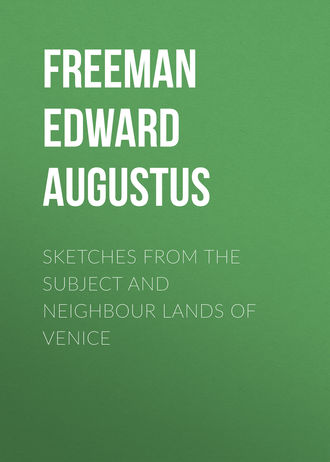 полная версия
полная версияSketches from the Subject and Neighbour Lands of Venice

CATHEDRAL, TRANI.
Fully to take in the effect of this grand church, it will be well not to hurry towards it on reaching the city. Go straight from the railway-station towards another bell-tower, not to that of the duomo. That course will lead to the so-called villa or public garden. The suppressed Dominican convent close by its gate has no attractive feature except its tower, one of the usual Italian type, only with pointed arches. But the grounds of the villa, raised on the ancient walls of the monastic precinct, look down at once on the waves of Hadria. In the northern view we look out on lands and hills beyond the water; but no man must dream that the eastern peninsula of Europe is to be seen from Trani. We look out only over the gulf of Manfredonia – the name of the Hohenstaufen king is as it were stamped upon the waters – to the Italian peninsula of Mount Garganus. Hence, on our way to the metropolitan church, we pass by the basin which forms the haven of Trani, a basin which reminds us of the cala which is all that is left of the many waters of Palermo. The distant view clearly brings out its main outline; above all, it brings out those arrangements of the eastern end which form the most characteristic feature. We see the tall tower at the south-west corner; we see the line of the clerestory with its small round-headed windows; above all, we see – so unlike anything in Northern architecture – the tall transept seeming to soar far above the rest of the church, with the three apses, strangely narrow and lofty, treated simply, as it would seem, as appendages to the transept itself. Those who have not seen Bitonto and Bari will not guess how great a danger these soaring apses have escaped. The Norman of Apulia did not, like the native Italian, deal in detached bell-towers; he clave to the use of his native land which made the tower or towers an integral part of the church. But he seems to have specially chosen a place for them which is German rather than Norman, and then to have treated them in a way which is neither German, Norman, nor Italian. At Bitonto and in the two great churches of Bari, a pair of towers flanks the east end. In Italy it might be safer to say the apse end; but we think that in all these cases the apse end is the east end or nearly so. Such pairs of eastern towers are common in Germany; but there the great apse projects between them. At Bari and Bitonto the whole apsidal arrangement is masked by a flat wall. The towers rise above the side apses; the great central apse is hidden by the wall carried in front of it. We thus get at the east end a flat front, like a west front; we lose the curves of the apses, and with them the arcades and grouped windows which form so marked a feature in the ordinary Romanesque of Germany and Italy. A single window, of larger size than Romanesque taste commonly allows, marks the place of the high altar. And this window is adorned with shafts and mouldings of special richness, and with animal figures above and below the shafts. Now here at Trani, though all the apses stand out, yet a like arrangement is followed. The central apse has only a single window of the same enriched type; the side apses have also only a single window each, but of a much plainer kind. Thus much, without taking in every detail, we can mark in our distant view; we can mark too somewhat of the unusually rich and heavy cornice of the transept, and the upper part of the transept front, the wheel window and the two rich coupled windows beneath it. We can mark too the arrangements of the great square tower, crowned with its small octagonal finish; and even here we can see that, with all its majesty of outline, it is far from ranking in the first class of Italian bell-towers. Its composition lacks boldness and simplicity, while it has nothing remarkable in the way of ornament. Saint Zeno among the simpler towers, Spalato among the more elaborate, stand indeed unrivalled. But the cathedral tower of Trani, when closely examined, is less satisfactory than its own majestic neighbour at Bari. It is not merely that the pointed arch, always out of place in an Italian bell-tower, is used in the upper stages. The pointed arch is used with better effect, both far away in the noble tower of Velletri, and close by at Trani itself, in the far humbler tower of the Dominican church. The fault lies in this, that the windows, instead of being spread over the whole face of each stage, are gathered together in the centre of each, while two of them have rather awkward pointed canopies over the groups of windows. Still, seen from far or near, it is a grand and majestic tower, though its faults, which catch the eye at a distance, become more distinct as we draw nearer.
The road by which we approach the duomo will give us no view of it from the west, and, till we come quite near to the church, we shall hardly see how closely it overhangs the sea. We take our course by the harbour, for part of the way is under heavy and dark arcades which remind us of Genoa. Presently, before we reach the great church, we come across the east end of a smaller one, with which we shall afterwards become better acquainted from its western side. At this end it seems to be called Purgatorio; at the other end we shall find that its true name is Ogni Santi– All Hallows. Here there is no transept; still the three apses may pass for a miniature of those in the metropolitan church; there is the same single large and elaborate window in the mid apse, the same smaller single windows in the side apses. We go landwards for a short way, and we presently find ourselves on a terrace overlooking the sea, close under the east end of the duomo. We now better take in both the grandeur and the singularity of the building whose general effect we have studied from a distance. We take in some fresh features, as the tall blank arcades along the walls, a feature shared by Trani with Bari, and we guess that the extraordinary height of the apses must be owing to the presence of a lofty under-church. We see signs too at the east end which seem to show that at some time or other there was a design for some other form of east end, inconsistent with the present design. The visitor will now perhaps be tempted to go at once within, though he ought in strictness to pass under the tower in order to finish his outside survey at the west end. It is curious to see how the same feeling which prevails in the east end prevails in the west front also. Here we have no continuous arcades like Pisa, Lucca, and Zara – happily we have no sham gables like the great one at Lucca; we have again the single great window with the small ones on each side. Only here the mid window has over it a rich wheel, the favourite form of the country, a form which the apsidal east end would not allow. And it is treated in exactly the same way, with the same kind of surrounding ornaments, as the single-light windows.
This west front, as it now stands, has a rather bare look; the windows have too much the air of being cut through the wall without any artistic design, and there is too great a gap between the windows and the west doorway with its flanking arcades below. But this last fault at least is not to be charged on the original design, which clearly took in a projecting portico. We may doubt however whether the portico could have been high enough to have much dignity, and we shall find this feature far more skilfully treated in the other smaller church of which we have already spoken. And here we must confess that it is possible to make two visits to Trani, and each time to make a somewhat careful examination of its great church, and yet to miss – not at all to forget to look for, but to fail to find – the bronze doors which form one of the wonders of Trani. This may seem incredible at a distance; it will be found on the spot not to be wonderful. We will not describe the doors at second-hand; we will rather hasten within to gaze on the surpassing grandeur of an interior, which, as an example of architectural design, may, as we have already hinted, rank beside the church by the Arno and the church by the Wear, beside the Conqueror's abbey at Caen and King Roger's chapel at Palermo.
We say King Roger's chapel advisedly; for the palace chapel of Palermo, were every scrap of its gorgeous mosaics whitewashed over, would still rank, simply as an architectural design, among the most successful in the world. And the chapel of Palermo has points which at once suggest comparison and contrast with the great church of Trani. We see the traces of the Saracen in both; but at Palermo the building itself is thoroughly Saracenic, at Trani the Saracen contributes only one element among others. In Sicily, where the Saracen was thoroughly at home, the Norman kings simply built their churches and palaces in the received style of the island, a style of which the pointed arch was a main feature. In southern Italy, where the Saracen was only an occasional visitor, a style arose in which elements from Normandy itself – elements, that is, perhaps brought first of all from northern Italy – are mixed with other elements to be found on the spot, Italian, Saracenic, and Byzantine. The churches of Bari, Bitonto, and Trani, all show this mixture in different shapes. One feature of it is to take the detached Italian bell-tower, and to make it, Norman fashion, part of the church itself. In such cases the general character of the tower is kept, but Norman touches are often brought into the details; for instance, the common Norman coupled window, such as we are used to in Normandy and England, often displaces the œcumenical mid-wall shaft which the older England shared with Italy. Thus here at Trani, the tower joins the church, though it is not made so completely part of its substance as it is at Bari and Bitonto. The inside of the church shows us another form of the same tendency. The Norman in Apulia could hardly fail to adopt the columnar forms of the land in which he was settled; but he could not bring himself to give up the threefold division of height and the bold triforium of his own land. An upper floor was not unknown in Italy, as we see in more than one of the Roman churches, as in Saint Agnes, Saint Laurence, and the church known as Quattro Coronati, to say nothing of Modena and Pisa, and Sta. Maria della Pieve at Arezzo. But in some of these cases the arrangement is widely different from the genuine Norman triforium, and the threefold division certainly cannot be called characteristically Italian, any more than characteristically Greek. But it is characteristically Norman; and when we find it systematically appearing in churches built under Norman rule, we must set it down as a result of special Norman taste. At Trani each of the seven arches of the nave has a triplet of round arches over it, and a single clerestory window above that. The Norman in his own land would have made more of the clerestory; he would have drawn a string underneath it to part it off from the triforium; he would have carried up shafts to the roof to mark the division into bays. But the triforium itself, as it stands at Trani, might have been set up at Caen or Bayeux, with only the smallest changes in detail. But where in Normandy, where in England, where, we may add, in Sicily, is there anything at all like the arcades which in the church of Trani support this all but thoroughly Norman triforium? These have no fellow at Bitonto; they have hardly a fellow at Bari. In those cities the Norman adopted the columnar arcades of the basilica, while in Sicily the Saracen still at his bidding placed the pointed arch on the Roman column. At Trani too we see the work, or at least the influence, of the Saracen; but it takes quite another form. The pointed arch would have been out of place; in Normandy and England it is ever a mark of the coming Gothic, and there is certainly no sign of coming Gothic at Trani. But the coupling of two columns with their capitals under a single abacus – sometimes rather a bit of entablature – to form the support of an arch, is a well-known Saracenic feature. Not that it was any Saracen invention. In architecture, as in everything else, the Saracen was, as regards the main forms, only a pupil of Rome, Old and New; but, exactly like the Norman, he knew how to develope and to throw a new character into the forms which he borrowed. The coupled columns may truly be called a Saracenic feature, though the Saracen must have learned it in the first instance from such buildings as the sepulchral church known as Saint Constantia at Rome. We may fairly see a Saracenic influence in a crowd of Christian examples where this form is used in cloisters and other smaller buildings where the arches and columns are of no great size. It is even not uncommon in strictly Norman buildings in positions where the shafts are merely part of the decorative construction, and do not actually support the weight of the building. It was a bolder risk to take a pair of such columns, and bid them bear up the real weight of the three stages of what we may fairly call a Norman minster.

CATHEDRAL, TRANI, INSIDE.
But the daring attempt is thoroughly successful; there is not, what we might well have looked for, any feeling of weakness; the twin columns yoked together to bear all that would have been laid on the massive round piers of England or their square fellows of Germany, seem fully equal to their work. It may be that the appearance of strength is partly owing to the use of real half-columns, and not mere slender vaulting-shafts, to support the roofs of the aisles. But the slender shaft comes in with good effect to support both the arch between the nave and the transept, and the arch between the transept and the great apse. The lofty transept is wholly an Italian idea; but the general idea of these two tall arches is thoroughly Norman.
In looking at such a church as this, so widely different from any of the many forms with which we are already familiar, there is always a certain doubt as to our own feelings. We admire; as to that there is no doubt. But how far is that admiration the result of mere wonder at something which in any case is strange and striking? how far is it a really intelligent approval of beauty or artistic skill? Both feelings, we may be pretty sure, come in; but it is not easy to say which is the leading one, till we are better acquainted with the building than we are likely to become in an ordinary journey. It is familiarity which is the real test. It is the building which we admire as much the thousandth time as the first which really approves itself to our critical judgement. We have not seen Trani for the thousandth time; but we did what we could; we were so struck with a first visit to Trani that, at the cost of some disturbance of travelling arrangements, we went there again, and we certainly did not admire it less the second time than the first. And, whatever may be the exact relation of the two feelings of mere wonder and of strictly critical approval, it is certain that a third feeling comes in by no means small a measure. This is a kind of feeling of historic fitness. The church of Trani is the kind of church which ought to have been built by Normans building on Apulian ground, with Greek and Saracen skill at their disposal.
But at Trani, as commonly in these Apulian churches, it is not enough to look at the building from above ground. The great height of the apses will have already suggested that there is a lower building of no small size; and so we find it, conspicuously tall and stately, even in this land of tall and stately under-churches – crypt is a word hardly worthy of them. The under-church at Trani shows us a forest of tall columns, some of them fluted, with a vast variety of capitals of foliage. A few only can be called classical; some have the punched ornament characteristic of Ravenna. A good many of the bases have leaves at the corners, a fashion which in England is commonly a mark of the thirteenth century, but which in Sicily and Dalmatia goes on at least till the seventeenth.
But the metropolitan church is not all that Trani has to show. In some of the buildings which we pass by in its narrow streets, we see some good windows of the style which it is most easy to call Venetian, though it might be rash hastily to refer them to the days of Venetian occupation. And there are other windows seemingly of earlier date, certainly of earlier character, which bear about them signs of the genuine Norman impress. But the strength of Trani, even setting aside the great church, lies in its ecclesiastical buildings; the best pieces even of domestic work are found in one of the monasteries. Two smaller churches deserve notice; one of them deserves special notice. This is the church of All Saints, of which we saw the east end on our way to the great minster, and on whose west end we shall most likely light as we come away from it. That west end is covered by a portico, or rather something more than a portico, as it contains a double row of arches. The front to the street forms part of a long and picturesque range of building, of which the actual arcade consists of four arches. One only of these is pointed, and that is the only one which rests on a column, the others being supported by square piers. But beyond this outer range, the vaulted approach to the church displays a grand series of columns and half-columns, with capitals of various forms. One is of extraordinary grandeur, with the volutes formed of crowned angels; the forms of the man and the eagle, either of them good for a volute, are here pressed into partnership. Within, the church is a small but graceful basilica, which, notwithstanding some disfigurements in 1853 which are boastfully recorded, pretty well keeps its ancient character, its columns with their capitals of foliage. He who visits Trani will doubtless also visit Bari, and such an one will do well both to compare the great church of Trani with the two great churches of Bari, and to compare and contrast this smaller building with the smaller church at Bari, that of Saint Gregory. Besides this little basilica, Trani possesses, not in one of its narrow streets, but in its widest piazza, a church, now of Saint Francis, but which, among many disfigurements, still keeps the form of the Greek cross within, and some Romanesque fragments without. Here, as also at Bari and at Bitonto, oriental influences – something we mean more oriental than Greeks or even than Sicilian Saracens – may be seen in the pierced tracery with which some of the windows are filled. In these cases this kind of work suggests a mosque; with other details, it might have carried our thoughts far away, to the great towers of the West of England.
Among the other members of this group of cities we might have expected to find Brindisi, so famous as a haven of the voyager in Roman days, and no less famous in our own, fill a high, if not the highest, place among its fellows. And Brindisi has its points of interest also, one of them of an almost unique interest. Over the haven rises a commemorative column – its fellow has left only its pedestal – which records, not the dominion of Saint Mark, but the restoration of the city by the Protospatharius Lupus. Is this he whose name has been rightly or wrongly added to certain annals of Bari? Anyhow there the column stands, one of the few direct memorials of Byzantine rule in Italy. There is the round church also, the mosaic in the otherwise worthless cathedral, and one or two fragments of domestic work. The lie of the city and its haven is truly a sight to be studied; we see that in whatever language it is that Brentesion means a stag's horn, the name was not unfittingly given to the antler-like fiords of this little inland sea. We trace out too the walls of Charles the Fifth, and we see how Brindisi has shrunk up since his day. But we are perhaps tempted to do injustice to Brindisi, to hurry over its monuments, when we are driven to choose between Brindisi and the greater attractions of the furthest city of our group, in some sort the furthest city of Europe. We pass by Lecce, which lies outside our group, as between Trani and Brindisi we have been driven to pass Monopoli, the spot which saw the first beginnings of the short Venetian rule in these parts. Everything cannot be seen, and we shall hardly regret sacrificing something to hasten to a spot which may well call itself the end of the world, and which forms the most fitting link between the central and the eastern peninsulas of Europe.
OTRANTO
1881Hydrous, Hydruntum, Otranto, has as good a claim as a city can well have to be looked on as the end of the world. It is very nearly the physical end of the world in that part of the world with which it has most concern. When we have reached Otranto, we can go no further by any common means of going. It may pass for the south-eastern point of the peninsula of Italy: it is the point where that central peninsula comes nearest to the peninsula which lies beyond it. It is the point where Western and Eastern Europe are parted by the smallest amount of sea. It has therefore been in all times one of the main points of communication between Eastern and Western Europe. The old Hydrous appears as a Greek colony, placed, as one of the old geographers happily puts it, on the mouth either of the Hadriatic or of the Ionian sea. Hydruntum appears in Roman days as a rival route to Brundisium for those who wish to pass from Italy into Greece. A city so placed naturally plays its part in the wars of Belisarius and in the wars of Roger. Held by the Eastern Emperors as long as they held anything west of the Hadriatic, it passed, when the Norman came, into the hands of Apulian Dukes and Sicilian Kings, and it remained part of the continental Sicilian kingdom, save for the two moments in its history which bring it within our immediate range. Otranto is the one city of Western Europe in which the Turk has really reigned, though happily for a moment only. It is one of the cities in this corner of Italy which formed, for a somewhat longer time, outlying posts of Venetian dominion; and it is a spot where the memory of the Turk and the memory of the Venetian are mingled together in a strange, an unusual, and a shameful way. In most of the other spots which have seen the presence of the Turk and the Venetian, the commonwealth which was the temple-keeper of the Evangelist shows itself only in its nobler calling, as "Europe's bulwark 'gainst the Ottomite." At Otranto, Venice appears in a character which is more commonly taken by the Most Christian King. Before Francis and Lewis had conspired with the barbarian against their Christian rivals, the Serene Republic had already stirred him up to make havoc of a Christian city.
At Otranto then we finish our journey by land, and from Otranto, as Otranto is now, we have no means of continuing it by sea. We cannot sail straight, as men did in old times, either to Corfu or to Aulona. To make our way from the central to the south-eastern peninsula, we have to make the "iter ad Brundisium" back again from the other side. It is the natural consequence of being at the end of the world, that when we reach the point which holds that place, we have to go back again. And when we find ourselves at Otranto, the fact that we are at the end of the world, that we have reached the end, not only of our actual journey, but of any possible journey of the same kind, is forcibly set before us as a kind of symbol. We have come to an end, to a very marked end, of the great railway system of central Europe. From any place within that system we can find our way to Otranto by the power of steam. Beyond Otranto that power can take us no further; indeed we have so nearly reached the heel of the boot that there is not much further to go by the help of any other power. We are at the end of Italy, at the end, that is, of the central peninsula of Europe, in a sense in which we are not even at more distant Reggio. For Reggio is before all things the way to Sicily, and Sicily we must allow to be geographically an appendage to Italy, strongly as we must assert the right of that great island to be looked on historically in quite another light. And that at Otranto we have distinctly reached the end of something is clearly set forth by the arrangements of the railway station itself. The rails come to an end; the buildings of the station are placed, not at the side of the line, but straight across it, a speaking sign that we can go no further, and that the thought of taking us further has not entered the most speculative mind.







